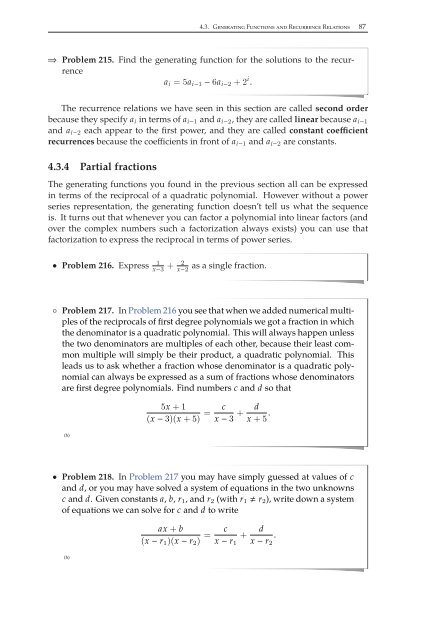Combinatorics Through Guided Discovery, 2004a
Combinatorics Through Guided Discovery, 2004a
Combinatorics Through Guided Discovery, 2004a
Create successful ePaper yourself
Turn your PDF publications into a flip-book with our unique Google optimized e-Paper software.
4.3. Generating Functions and Recurrence Relations 87<br />
⇒<br />
Find the generating function for the solutions to the recur-<br />
Problem 215.<br />
rence<br />
a i =5a i−1 − 6a i−2 +2 i .<br />
The recurrence relations we have seen in this section are called second order<br />
because they specify a i in terms of a i−1 and a i−2 , they are called linear because a i−1<br />
and a i−2 each appear to the first power, and they are called constant coefficient<br />
recurrences because the coefficients in front of a i−1 and a i−2 are constants.<br />
4.3.4 Partial fractions<br />
The generating functions you found in the previous section all can be expressed<br />
in terms of the reciprocal of a quadratic polynomial. However without a power<br />
series representation, the generating function doesn’t tell us what the sequence<br />
is. It turns out that whenever you can factor a polynomial into linear factors (and<br />
over the complex numbers such a factorization always exists) you can use that<br />
factorization to express the reciprocal in terms of power series.<br />
• Problem 216. Express 1<br />
x−3 + 2<br />
x−2<br />
as a single fraction.<br />
◦ Problem 217. In Problem 216 you see that when we added numerical multiples<br />
of the reciprocals of first degree polynomials we got a fraction in which<br />
the denominator is a quadratic polynomial. This will always happen unless<br />
the two denominators are multiples of each other, because their least common<br />
multiple will simply be their product, a quadratic polynomial. This<br />
leads us to ask whether a fraction whose denominator is a quadratic polynomial<br />
can always be expressed as a sum of fractions whose denominators<br />
are first degree polynomials. Find numbers c and d so that<br />
5x +1<br />
(x − 3)(x +5) = c<br />
x − 3 +<br />
d<br />
x +5 .<br />
(h)<br />
• Problem 218. In Problem 217 you may have simply guessed at values of c<br />
and d, or you may have solved a system of equations in the two unknowns<br />
c and d. Given constants a, b, r 1 , and r 2 (with r 1 r 2 ), write down a system<br />
of equations we can solve for c and d to write<br />
ax + b<br />
(x − r 1 )(x − r 2 ) = c<br />
x − r 1<br />
+<br />
d<br />
x − r 2<br />
.<br />
(h)


















